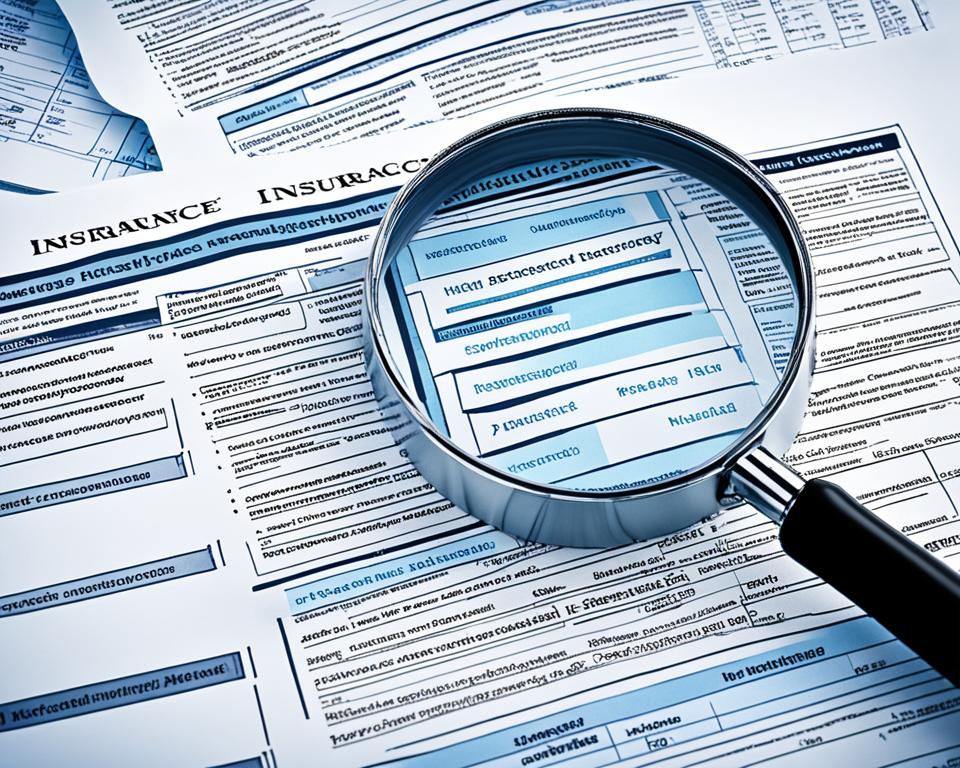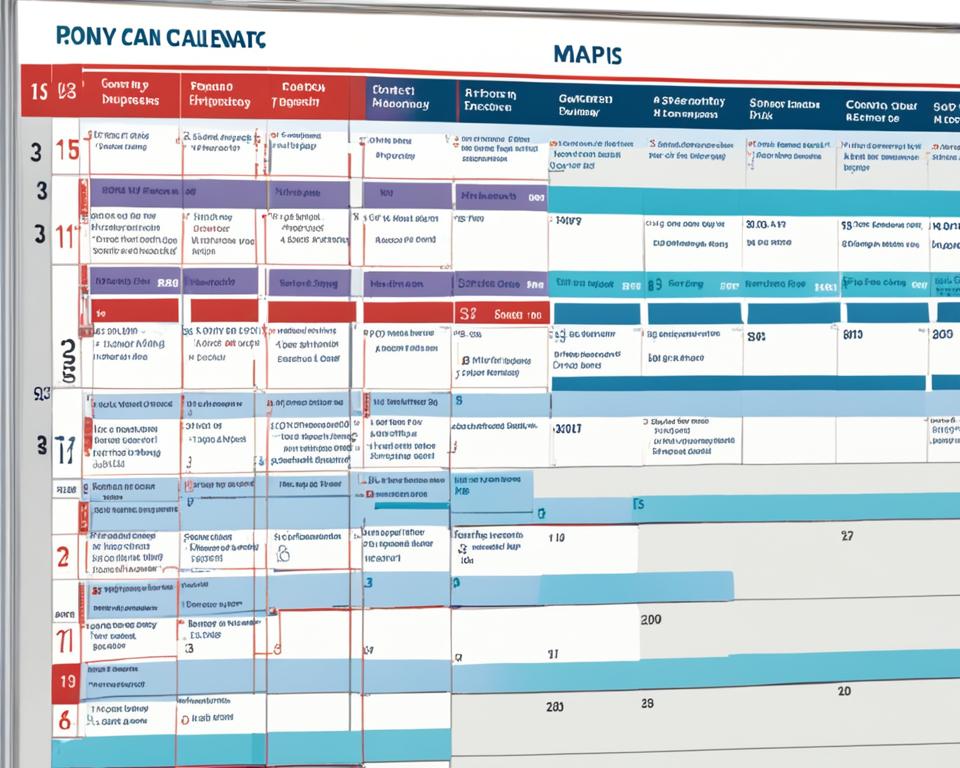Life insurance can seem hard to figure out. But, this guide is here to make it simple. It gives you all the key info to make smart choices. You’ll learn about different policies, premiums, and how to claim. This way, you can look after the people you care about.1 This guide works for everyone. Whether you’re getting life insurance for the first time or checking your current plan, it shows you the way. You’ll know how to pick what’s best for your family and you.
Key Takeaways
- Comprehensive overview of life insurance fundamentals
- Understanding policy types, including term, whole, and universal life insurance
- Guidance on determining appropriate coverage and premiums
- Insights into the medical underwriting process and optional riders
- Step-by-step guide to the life insurance claim process
The Significance of Life Insurance
Life insurance is key for your financial plan, providing a safety net for your family if you die early.2 It steps in to make up for your lost income. This lets your dependents keep up their lifestyle and handle crucial costs.2
Replacing Lost Income
If you die, your family might face a huge cut in income, which can be overwhelming. Life insurance replaces this lost income. It offers your family the money they need for daily expenses. This includes paying the mortgage, bills, and meeting living costs.2
Protecting Loved Ones from Debt
Life insurance does more than just replace income. It also helps in paying off debts like mortgages and medical bills.2 The payout from your policy can clear these debts. This helps prevent extra financial pressure on your family during a hard time.
Tax-Free Proceeds for Beneficiaries
Life insurance’s benefits are usually tax-free.2 So, your family gets the full payout. They can use this money without worrying about taxes. It’s a big plus for keeping their financial peace intact.
Determining Your Life Insurance Needs
Finding the right life insurance amount isn’t easy. It involves looking at your financial situation and what your family needs. Think about costs like funerals and debts right after your death.3 Also, include money for moving, taking care of kids, and the time needed to cope without you.3 Don’t forget ongoing costs such as bills and school fees.
Immediate Expenses at Time of Death
Start by thinking about the costs right after you pass. This might cover funeral and settlement fees. With enough life insurance, your family won’t have to worry about these immediate costs.3
Funds for Transitional Period
It’s also key to consider the period right after your death. Your family might need help with moving or kids. This helps your family keep on living without added financial worry.3
Ongoing Financial Obligations
Think about the bills that keep coming each month. Consider future costs like school fees. By covering these needs, your family can still live well and achieve their dreams.3

Choosing the right life insurance is very personal. It’s vital to look at what you have and what your family will need. By looking at all these cost types, you can make a life insurance plan that truly supports your family.3
Life Insurance Basics
Understanding the core of life insurance is key before diving deep. You and an insurer create a contract. You pay a premium, and in return, a death benefit goes to your beneficiaries when you die.4 This benefit helps your loved ones financially, covering everything from daily expenses to bigger costs.
Term life insurance provides a benefit for 10 to 20 years.4 Some term policies can turn into longer term ones later. There are also options like whole, universal, and variable universal life insurance, offering longer protection. Whole life insurance provides cover permanently.4 Your age, gender, health, lifestyle, and job affect the insurance cost. For some policies, getting dividends can increase their value and coverage.4 New York Life has given dividends every year since 1854,4 and is rated highly by financial strength assessors.
The term of term life insurance can be from one to 30 years.2 With traditional whole life, premiums stay the same forever. It pays a benefit when the person covered dies.2 Universal life is more flexible, while variable life insurance units let you invest in different financial products.2 You can borrow or withdraw cash value from your life insurance.2 Some states increase their state estate tax to make up for the federal tax decrease when people die.2 And, by naming charity as a beneficiary in your life insurance, you can make a big contribution.2
Understanding Policy Types
There are three main life insurance types to look at: term, whole, and universal. Each one has its own benefits depending on what you need and prefer financially.5
Term Life Insurance
Term life insurance is simple and usually cheaper. It covers you for a fixed time, like 10 to 30 years. It’s great for covering needs like raising kids or earning the most money.5
Whole Life Insurance
Whole life insurance is for life and has a cash value feature. The payments are the same all the time. Its cash value grows certain every year. It’s a solid choice for permanent coverage and future money needs.5
Universal Life Insurance
Universal life insurance is a mix of the two others, offering more payment and coverage flexibility. The amount you pay, get at death, and the cash value can change. This makes it more complex than whole life insurance.5
It’s important to think about what you really need from life insurance. Do you have a budget? What are your long-term financial plans? Talking to an expert and looking at different policies helps you pick the best coverage. This ensures your family is financially protected.5
Premiums and Coverage Amounts
Life insurance costs depend on several factors. These include your age, health, and lifestyle. The amount of coverage you choose also affects your premiums.6 Usually, younger and healthier people pay less. But those who are older or have health issues pay more.6 Your life insurance is also more expensive if you smoke or do risky stuff.6
Factors Affecting Premiums
Your expected lifespan is what insurance companies look at most. The timeframe of the policy also matters. Term life insurance is for 10, 20, or 30 years,6 but whole life lasts your whole life.6 Some policies, like indexed universal and variable universal life insurance, let you earn more from your policy’s cash value.6
Choosing Adequate Coverage
Picking the right coverage means thinking about what your family needs. This is for when you’re not around. It also covers your debts and liabilities.6 You usually need to show some ID, like a Social Security card, when you apply for life insurance.6

Beneficiary Designation
Choosing the right life insurance beneficiaries is key to looking after your family. It’s smart to pick primary and contingent beneficiaries. The primary beneficiary gets the money first.7 You’re allowed to name more than one. This lets you decide who gets what, like splitting 60% for one person and 40% for another.7
Naming Primary and Contingent Beneficiaries
The primary beneficiaries get the money first. This makes sure it goes to the people you’ve chosen.7 You can pick more than one, which gives you flexibility. It could be for different people or to share among many.7 Secondary or contingent beneficiaries get the money if the first choice can’t. They add extra protection to your plan.7 Others, called tertiary beneficiaries, get the money if the first two can’t. This makes the order clear.7 Always use the correct names. This avoids confusion and makes sure the right people get the money.7
Updating Beneficiary Information
Don’t forget to review and update your beneficiaries now and then. Life changes, like marriage or the loss of a loved one, need updating.8 It’s advised to rethink your choices once a year. This keeps your policy in line with your current life.8 If you don’t name a beneficiary, it can cause problems. This might delay the money getting to your loved ones.8 It helps to name contingent beneficiaries, especially for changing life situations. This can be crucial if you had a spouse as your main choice.8
In some places, like Arizona, a spouse might get 50% of the money by law. This is because of community property rules.8 If someone is an irrevocable beneficiary, their rights are protected. You can’t change their share without their okay.8 Using a trust as a beneficiary can be good for kids or people with special needs. It helps them keep their benefits.8 Talking to an estate-planning lawyer can be very helpful. They can tell you about setting up a trust to protect aids for people who need it.8
https://www.youtube.com/watch?v=AVoM2zvFhP0
The Medical Underwriting Process
Insurers look at your health to set life insurance prices and coverage properly. They check your health history, pre-existing conditions, and your drugs. Lifestyle habits that could increase your risk, like smoking, are considered.9 You might need a medical exam, lab tests, or a look at your medical records. This helps the insurer know your health fully.9
Getting life insurance can be quick or slow, and it varies. It depends on things like if you need a medical exam, the policy size, and if there are any issues in your application.10 Insurers look at many details, such as your financial status and your job, during this process. They also check your prescription and credit history, your family’s health, and your driving record.10
If you smoke a lot or drink often, you may pay more for insurance, or they might not insure you.9 Jobs that are riskier could also mean higher costs for you.9 They even look at your family’s health, especially if they have certain diseases.9
Giving complete and correct information while applying is very important. This avoids problems and helps keep costs down.9 They might ask for things like your ID, financial statements, and medical records as evidence.9
Checking your health and medical info is a big part of setting life insurance prices.10 At this time, they decide how risky you are. Your risk level affects how much you’ll pay.10
A detailed process can mean you pay less for insurance. That’s because it helps the insurer understand your risks better.10

Riders and Endorsements
Life insurance often comes with extra benefits called riders and endorsements. These help boost the coverage and offer more perks to the policyholder.11 Riders let policyholders add more coverage or change what’s already there. This can cost more along with the regular premiums.
Some types of riders are for long-term care, turning term insurance into permanent, and waiving premiums if you get sick.11 For example, long-term care (LTC) can be added to products like whole or variable life insurance.
Waiver of Premium for Disability
The waiver of premium for disability is a key rider. If you’re too sick or hurt to work, it lets you stop paying your premiums for a while.11 This helps people when they’re seriously sick or injured, by covering their payments.
Accelerated Death Benefits
The accelerated death benefit rider is also valuable. It gives you some of your death benefit early if you’re terminally ill or need long-term care.12 Letting policyholders access their death benefit if they get a serious diagnosis is why it’s so popular.313 Many people choose this rider, knowing they can use their benefits towards health expenses when they need it most.13
Child Rider
Then, there’s the child rider. It offers life insurance for your kids. This coverage helps families through the hard times if a child passes away.12 Term life insurance can be added for kids at various ages, depending on the insurance company.12
Policy Effective Dates and Grace Periods
When you buy a life insurance policy, it’s key to know when coverage starts. This is the effective date. It’s the day your policy goes into effect. If the insured dies, the insurance provider will pay out.
Grace periods are also important. They let you pay your premium late without losing your policy. If you get an advance premium tax credit (APTC), you have three months as a grace period. For those without an APTC, state and regulatory laws decide their grace period, usually 30 or 31 days.14
If you don’t pay all owed premiums by the end of the grace period, your coverage might stop. This happens typically at the end of the month of your last paid premium. It depends on whether you receive an APTC or not.14
For special enrollment periods (SEPs), when your policy start date can go back in time, remember this. You have at least 30 days after choosing a plan to pay your first premium.
Knowing about life insurance policy effective dates and grace periods is essential. It means your coverage won’t end unexpectedly.

Handling Policy Lapses and Reinstatement
If you miss paying premiums, your life insurance policy might lapse. This means you lose your coverage.15 But, you could still get it back. You’ll need to prove you can be insured and catch up on payments.15 Remember, each policy may have different rules for reinstatement.
Life insurance companies give you about a month after your payment’s due to catch up.15 If you pass away in this time, your family might still be paid. But, that payment will be less because it goes toward what you owe.15 For term life insurance, missing a payment during this grace period means no more coverage.
You might have three to five years to restart your policy after it lapsed, with specific conditions.15 If you’re late, there could be a 6% interest rate on what you owe.15 Reinstating might save you money because you get to keep the original rate and maybe even get discounts.15 Sometimes, an insurer might let you slide for 15 to 30 days without extra hoops to jump through to get it back on track.15
For each year you wait to buy a new policy, the price could go up by 6% because of age.15 You might be able to use the cash from a permanent life policy to keep it going for a bit.15 If the policy lapses and you die, your family might not get the benefits. Although, they can chat with the insurer about paying the missed premiums to try and get something.15
Policies normally have a 31-day grace period after the due date to catch up.16 Insurers usually allow up to five years to get a lapsed policy back in effect.16 Within the first two years of a policy, the insurer might look closely into the cause of death.16 But they must pay up within two months of proof of death.16
Many companies give you 10 to 20 days to look over the policy after you buy it.16 You can get your money back if you change your mind within this time.16 You might also get a refund if the insurer finds a reason not to pay, like if the death was self-inflicted, within the first two years of getting the policy.16
The Life Insurance Claim Process
When you need to file a life insurance claim, knowing the steps is key. First, inform the insurance company about the policyholder’s death. Then, the beneficiaries must prepare some documents like the death certificate and ID.17
Filing a Claim
Most insurance firms send a check within seven days of getting the claim.17 They might offer postdated checks. Another option could be to get the money directly in a bank account on a later date.17 The time it takes to review a claim and send the money depends on the case’s complexity.18
Required Documentation
For a death claim, you’ll need a death certificate and the policy itself. For deaths from accidents, you should have a police report and a post-mortem. Illness-related deaths require medical records. Other documents may also be necessary.17 For critical illness or accidents, bring copies of test results and hospital stays.17
Claim Processing Timelines
After receiving all paperwork, insurance companies aim to finalize claims within 30 days.17 They may investigate further for up to 90 days after being informed of the claim.17 Delays might happen if there’s a need for more investigation.18 Also, if the insured passes within the first two years, beneficiaries might wait from 6 to 12 months because of certain policy rules.18
Conclusion
This guide has given you a solid understanding of life insurance basics. It helps you go through the different policy types, how premiums work, and the claims process.6 Think about what you and your family need. This way, you can choose the right coverage to keep them safe financially, even if you’re not there.19 Life insurance is key to a strong financial plan. With this info, you can start protecting your loved ones with confidence.
Key takeaways from this guide are knowing the main types of life insurance policies like term, whole, and universal.6 You also learned what affects your premium and how to pick the right coverage for you.19 It’s important to name the right beneficiaries and go through the medical check. And check out extra coverage you can add to your plan.
Now, you’re ready to start your life insurance journey with what you’ve learned. Be sure to make choices that will support your family financially if something happens to you. Keeping to life insurance basics is vital for a good financial plan. By understanding and using these ideas, you’re doing a major thing to take care of your family’s future.
FAQ
What is the primary purpose of life insurance?
How do I determine the appropriate amount of life insurance coverage?
What are the three primary types of life insurance policies?
What factors affect the cost of life insurance premiums?
How do I properly name beneficiaries for my life insurance policy?
What is the medical underwriting process for life insurance?
What are some common life insurance riders and endorsements?
What happens if I fail to make the required premium payments?
What is the process for filing a life insurance claim?
Source Links
- https://www.bajajallianzlife.com/life-insurance-guide/life.html
- https://www.iii.org/article/life-insurance-basics
- https://www.nerdwallet.com/article/insurance/how-much-life-insurance-do-i-need
- https://www.newyorklife.com/resources/life-insurance-101
- https://www.doi.sc.gov/1018/Understanding-Life-Insurance
- https://www.investopedia.com/terms/l/lifeinsurance.asp
- https://www.protective.com/learn/understanding-beneficiary-options-in-a-life-insurance-policy
- https://www.forbes.com/advisor/life-insurance/choose-beneficiary/
- https://www.forbes.com/advisor/in/life-insurance/underwriting-in-life-insurance/
- https://aigd.life2.corebridgefinancial.com/about-life/applying-for-life-insurance/what-is-medical-underwriting
- https://www.investopedia.com/terms/r/rider.asp
- https://www.protective.com/learn/life-insurance-riders
- https://www.bankrate.com/insurance/life-insurance/life-insurance-riders/
- https://www.healthreformbeyondthebasics.org/key-facts-premium-payments-and-grace-periods/
- https://www.forbes.com/advisor/life-insurance/reinstate-lapsed-policy/
- https://www.opic.texas.gov/life-insurance/rights/
- https://www.lifeinscouncil.org/consumers/ClaimsProcess
- https://www.investopedia.com/articles/personal-finance/121914/life-insurance-policies-how-payouts-work.asp
- https://www.manning-napier.com/insights/an-introduction-to-life-insurance
